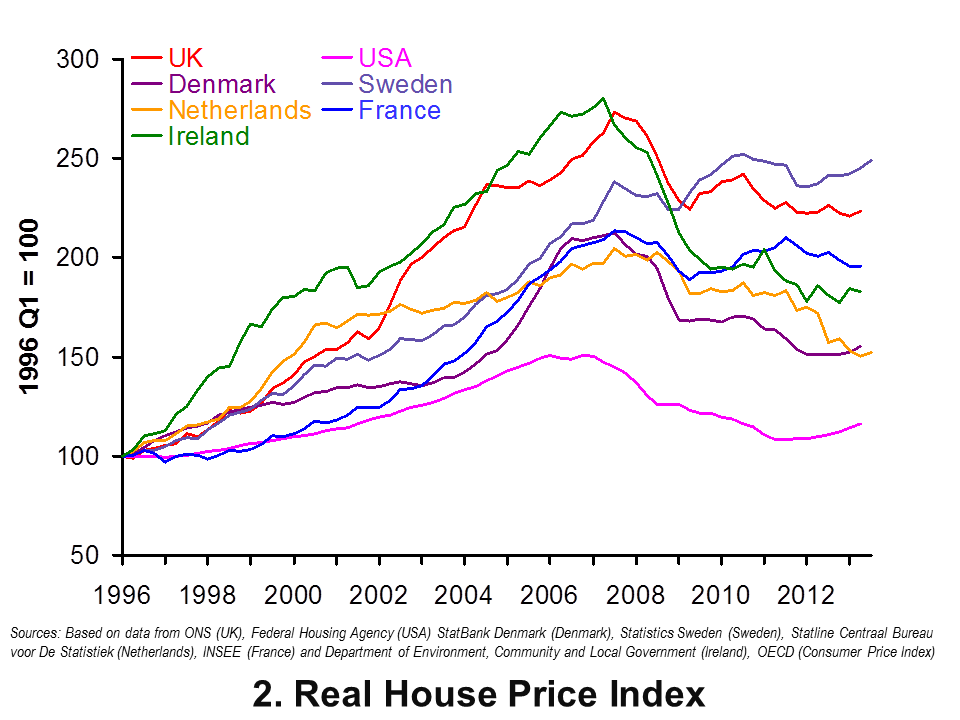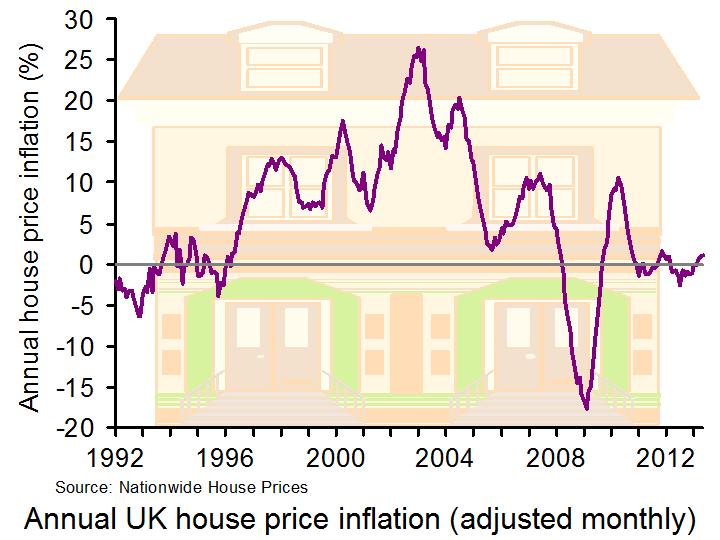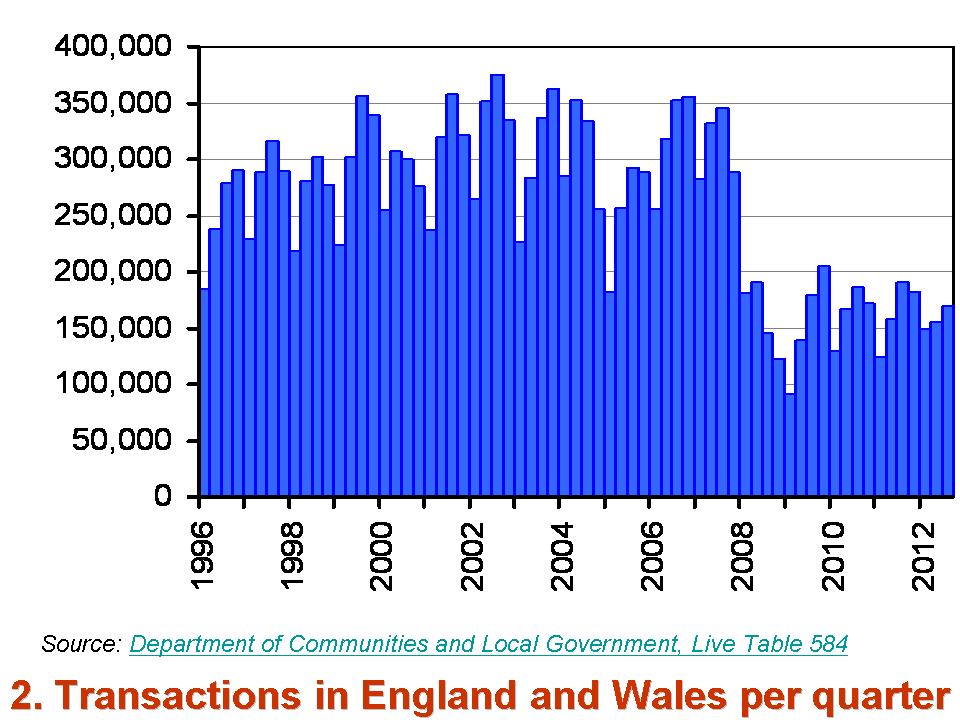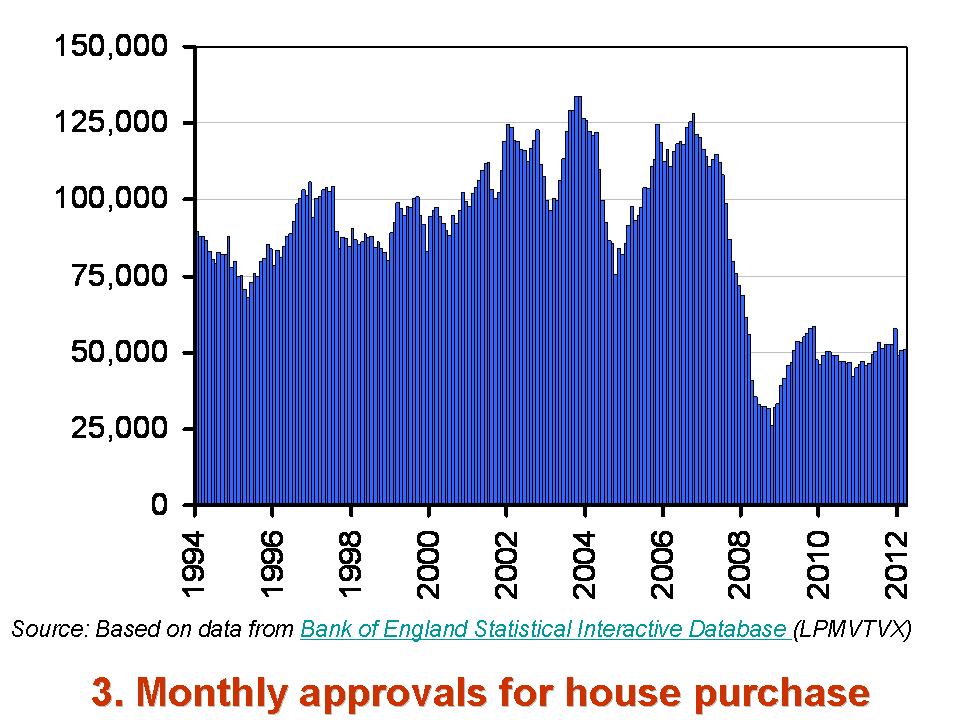 UK house prices are incredibly volatile. This helps to explain the fascination that many of us have with the British housing market. According to the latest ONS house Price Index, the average UK house price in August 2013 was 3.8 per cent higher than 12 months earlier. The rates varied across the home nations: 4.1 per cent in England, 1.1 per cent in Northern Ireland, 1 per cent in Wales and -0.7 per cent in Scotland. Here we take a look at international house price inflation rates. Is the British housing market as unique as we think it is?
UK house prices are incredibly volatile. This helps to explain the fascination that many of us have with the British housing market. According to the latest ONS house Price Index, the average UK house price in August 2013 was 3.8 per cent higher than 12 months earlier. The rates varied across the home nations: 4.1 per cent in England, 1.1 per cent in Northern Ireland, 1 per cent in Wales and -0.7 per cent in Scotland. Here we take a look at international house price inflation rates. Is the British housing market as unique as we think it is?
Let’s begin at home (excuse the pun). If we take the period from 1970 Q1 to 2013 Q2, the average annual rate of house price inflation across the UK is 9.7 per cent. The average rate in England is 9.8 per cent, as it is in Wales too, while in Scotland it is 9.0 per cent and in Northern Ireland it is 8.8 per cent. While the long-term averages of the UK nations are rather more similar than perhaps we might expect, what is quite interesting is the differences that emerge in more recent times. If we take the period from July 2008 to August 2013, the average annual rate of house price inflation in the UK is -0.2 per cent, in England it is 0.1 per cent, in both Wales and Scotland it is -1.0 per cent, while in Northern Ireland it is -11 per cent.
The recent English average is heavily distorted by London and to a lesser extent the rest of the South East. In London and the South East the average annual house price inflation rates since July 2008 have been 2.6 per cent and 0.2 per cent respectively. In all the other English regions the average rate has been negative. In my own region of the East Midlands the average rate has been -1.2 per cent – this is exactly the UK average if both London and the South East are removed from the figures.
 Now let’s go international. Chart 1 shows annual house price inflation rates for the UK and six other countries since 1997. Interestingly, it shows that house price volatility is a common feature of housing markets. It is not a uniquely British thing. It also shows that the USA is notable for its relatively robust house price inflation rates of late. In the first half of 2013 annual house price inflation has been running at 7 per cent in America, compared with 2 to 3 per cent here in the UK. In contrast, the Netherlands has seen near-double digit rates of house price deflation over the past year, albeit with a rebound in the third quarter of this year. (Click here to download a PowerPoint of the chart.)
Now let’s go international. Chart 1 shows annual house price inflation rates for the UK and six other countries since 1997. Interestingly, it shows that house price volatility is a common feature of housing markets. It is not a uniquely British thing. It also shows that the USA is notable for its relatively robust house price inflation rates of late. In the first half of 2013 annual house price inflation has been running at 7 per cent in America, compared with 2 to 3 per cent here in the UK. In contrast, the Netherlands has seen near-double digit rates of house price deflation over the past year, albeit with a rebound in the third quarter of this year. (Click here to download a PowerPoint of the chart.)
The chart captures very nicely the effect of the financial crisis and subsequent economic downturn on global house prices. Ireland saw annual rates of house price deflation touch 23 per cent in 2009 compared with rates of deflation of 12 per cent in the UK. Denmark too suffered significant house price deflation with prices falling at an annual rate of 15 per cent in 2009.
House price volatility appears to be an inherent characteristic of housing markets worldwide. Let’s now consider the extent to which house prices rise over the longer term. In doing so, we consider real house price growth after having stripped out the effect of consumer price inflation. Real house price growth measures the growth of house prices relative to consumer prices.
 Chart 2 shows real house prices since 1996 Q1. (Click here to download a PowerPoint of the chart.) It shows that up to 2013 Q2, real house prices in the UK have risen by a factor of 2.24, i.e. they are two and a quarter times higher. This is a little less than in Sweden where prices are 2.5 times higher.
Chart 2 shows real house prices since 1996 Q1. (Click here to download a PowerPoint of the chart.) It shows that up to 2013 Q2, real house prices in the UK have risen by a factor of 2.24, i.e. they are two and a quarter times higher. This is a little less than in Sweden where prices are 2.5 times higher.
Chart 2 shows that the increase in real house prices in the UK and Sweden is significantly higher than in the other countries in the sample. In particular, in the USA real house prices in 2013 Q2 are only 1.16 times higher than in 1996 Q1. In the US actual house prices, when viewed over the past 17 years or so, have grown only a little more quickly than consumer prices.
The latest data on house prices suggest that house price volatility is not unique to the UK. However the rate of growth over the longer term relative to consumer prices is markedly quicker than in many other countries. It is this which helps to explain the amount of attention paid to the UK housing market – and not least by policy-makers.
Data
House Price Indices: Data Tables Office for National Statistics
Articles
First time buyers in race to beat house price rises Telegraph, Nicole Blackmore (8/11/13)
House prices soar by £13,000: Values rise at fastest rate for 3 years Express, Sarah O’Grady (7/11/13)
House prices: ‘south-east set to outpace London’ for first time in a decade Guardian, Jennifer Rankin (6/11/13)
UK house prices hit record level, says ONS BBC News, (15/10/13)
UK house prices rise at fastest pace in three years in October – Nationwide Reuter (31/11/13)
 Jonathan Portes: UK house prices a ‘force of evil’ BBC News, (5/11/13)
Jonathan Portes: UK house prices a ‘force of evil’ BBC News, (5/11/13)
Questions
- What is meant by the annual rate of house price inflation? What about the annual rate of house price deflation?
- What factors are likely to affect housing demand?
- What factors are likely to affect housing supply?
- Explain the difference between nominal and real house prices. What does a real increase in house prices mean?
- How might we explain the recent differences between house price inflation rates in London and the South East relative to the rest of the UK?
- What might explain the very different long-term growth rates in real house prices in the USA and the UK?
- Why were house prices so affected by the financial crisis?
- What factors help explain the volatility in house prices?
 The strength of the housing market is often a key indicator of the strength of the economy. But, the opposite is also true: a weak economy often filters through to create a weak housing market. With the current weak economy, a boost in confidence is needed and signs suggest that the housing market is beginning to recover.
The strength of the housing market is often a key indicator of the strength of the economy. But, the opposite is also true: a weak economy often filters through to create a weak housing market. With the current weak economy, a boost in confidence is needed and signs suggest that the housing market is beginning to recover.
While the picture of the housing market today is nothing like the pre-crisis view, things are beginning to look up. For a couple of years now, house price inflation in the UK has been very close, if not equal to zero. However, data from Nationwide Building Society suggests that in May, house prices rose by 0.4% and the once stagnant year-on-year change in house prices rose to 1.1% (see chart below: click here for a PowerPoint of the chart). This is the fastest it has grown since the end of 2011.
Commentators have suggested that this latest data is an indication that ‘the market is gaining momentum’. A further confirmation of this rejuvenated market came with the data that property sales were 5% up each month this year, than the average monthly level for 2012. Despite this improvement, they still remain well below the pre-crisis levels.
 Which factors have contributed to this tentative recovery? Most households require a mortgage to purchase a house and, given the central role that the housing market played in the financial crisis with companies engaging in excessive lending as a means of expanding their mortgage books, the availability of mortgages fell. The number of mortgage approvals is likely to feed through to affect the number of house sales and these have improved in the first few months of 2013. Interest rates offered by lenders have also fallen, making mortgages more affordable, thus boosting demand. Furthermore, government assistance is available to help individuals put a deposit down on a house, by offering them an equity loan. Further measures are due to come into effect in January 2014, with the aim of providing a further boost to the housing market. The chief economist at Nationwide, Robert Gardner said:
Which factors have contributed to this tentative recovery? Most households require a mortgage to purchase a house and, given the central role that the housing market played in the financial crisis with companies engaging in excessive lending as a means of expanding their mortgage books, the availability of mortgages fell. The number of mortgage approvals is likely to feed through to affect the number of house sales and these have improved in the first few months of 2013. Interest rates offered by lenders have also fallen, making mortgages more affordable, thus boosting demand. Furthermore, government assistance is available to help individuals put a deposit down on a house, by offering them an equity loan. Further measures are due to come into effect in January 2014, with the aim of providing a further boost to the housing market. The chief economist at Nationwide, Robert Gardner said:
Widespread expectations that the economy will continue to recover gradually in the quarters ahead, that interest rates will remain low, and the ongoing impact of policy measures aimed at supporting the availability and lowering the cost of credit all provide reasons for optimism that activity will continue to gain momentum in the quarters ahead.
Despite the optimism, the situation is different across the UK, with some areas benefiting more than others. London and the South-East are driving this 0.4% rise, whereas other areas may be in need of further assistance to keep pace (see The UK housing market: good in parts).
Although these latest data may be a sign of things to come, it is also possible that things could go the opposite way. Incomes remain low; employment data are hardly encouraging; and the spectre of inflation is always there. Perhaps most importantly, consumer confidence remains fragile and until that gains momentum, uncertainty will continue to plague the UK marketplace. The following articles consider this issue.
Articles
UK house prices again up in May, says Nationwide The Guardian, Hilary Osborne (30/5/13)
Housing market could boost retail industry, Kingfisher says The Telegraph, Graham Ruddick (30/5/13)
UK house prices see modest rise, says Nationwide BBC News (30/5/13)
 Hugh’s Review: House prices in spotlight BBC News, Hugh Pym with Yolande Barnes of Savills and Matthew Pointon of Capital Economics (31/5/13)
Hugh’s Review: House prices in spotlight BBC News, Hugh Pym with Yolande Barnes of Savills and Matthew Pointon of Capital Economics (31/5/13)
House prices are racing ahead as stimulus for the market kicks in Independent, Russell Lynch (31/5/13)
’Pick up’ in house prices recorded in sign of market confidence, says Nationwide Independent, Vicky Shaw (30/5/13)
House prices at highest level for nearly two years as confidence in UK economy grows and mortgages get cheaper This is Money, Matt West (30/5/13)
Stamp duty is ‘choking’ housing market as it rises seven times faster than inflation over last 15 years Mail Online, Tara Brady (28/5/13)
Nationwide launches Help to Buy mortgages The Telegraph, William Clarke (29/5/13)
UK home prices rise most in 18 months, Nationwide says Bloomberg, Jennifer Ryan (30/5/13)
House price data
Links to house price data The Economics Network
Statistical data set – Property transactions Department of Communities and Local Government
Nationwide house price index Nationwide Building Society
Halifax House Price Index Lloyds Banking Group
Lending to individuals – November 2012 Bank of England
Questions
- How is the equilibrium determined in the housing market? Using a demand and supply diagram, illustrate the equilibrium. Make sure you think about the shapes of the curves you’re drawing.
- Which factors affect the demand for and supply of housing?
- Why are there regional variations in house prices?
- Why is the housing market a good indicator of the strength of the economy?
- Why have house prices risen throughout 2013? Is the trend likely to continue?
- If the housing market does indeed gain momentum, how might this affect the rest of the economy? Which sectors in particular are likely to benefit?
- Explain why the government’s intervention in the housing market could be seen to have a multiplier effect?
- Concerns have been raised that the government’s schemes to help the housing market may create a house price bubble. Why might this be the case?
 The housing market is an incredibly fascinating market to monitor and to research. The market was at the centre of the financial crisis with some lenders accused of over-aggressively expanding their mortgage books and relaxing their lending criteria. The UK housing market of today looks very different to the market before the financial crisis. Nationally, house prices are stagnant while transaction numbers are less than half their pre-crisis level. The UK housing market appears almost as ‘cold’ as the recent weather!
The housing market is an incredibly fascinating market to monitor and to research. The market was at the centre of the financial crisis with some lenders accused of over-aggressively expanding their mortgage books and relaxing their lending criteria. The UK housing market of today looks very different to the market before the financial crisis. Nationally, house prices are stagnant while transaction numbers are less than half their pre-crisis level. The UK housing market appears almost as ‘cold’ as the recent weather!

As the first chart shows, the annual rate of house price inflation across the UK has been consistently close to or even below zero over the past couple of years. The latest figures from the Nationwide Building Society point to the average UK house price in the final quarter of 2012 being 1.1 per cent lower than in the final quarter of 2011. The figures from the Halifax concur with their estimate showing UK house prices 0.3 per cent lower year-on-year in the final quarter of 2012. This is a very different picture from that during the 2000s. As recently as 2007, the annual rate of house price inflation was in excess of 10 per cent.
 Another indicator of the changing face of the UK housing market is the level of activity. The second chart shows the number of transactions per quarter across England and Wales since 1996. The figures from the Department of Communities and Local Government show that since the start of 2010 England and Wales has seen an average of 159,000 transactions per quarter. This compares with an average of 294,000 transactions over the period from 1996 to the end of 2007. Hence, the number of purchases today is roughly half the level prior to the financial crisis.
Another indicator of the changing face of the UK housing market is the level of activity. The second chart shows the number of transactions per quarter across England and Wales since 1996. The figures from the Department of Communities and Local Government show that since the start of 2010 England and Wales has seen an average of 159,000 transactions per quarter. This compares with an average of 294,000 transactions over the period from 1996 to the end of 2007. Hence, the number of purchases today is roughly half the level prior to the financial crisis.
 A further indicator of today’s very different housing market is the numbers of approvals by lenders for mortgages for house purchases. The latest Bank of England figures show that across the UK, the number of approvals each month in the first eleven months of 2012 averaged 51,000. Since 2010, the average monthly number of approvals has been 49,000. However, over the period from 1996 to the end of 2007 there were over 102,000 mortgages being approved each month.
A further indicator of today’s very different housing market is the numbers of approvals by lenders for mortgages for house purchases. The latest Bank of England figures show that across the UK, the number of approvals each month in the first eleven months of 2012 averaged 51,000. Since 2010, the average monthly number of approvals has been 49,000. However, over the period from 1996 to the end of 2007 there were over 102,000 mortgages being approved each month.
A trawl through some of the key indicators of the UK housing market helps to paint a picture of a market that is markedly different to that before the financial crisis. It would be a big surprise in today’s financial and economic climate if there were to be any significant change in the path of these indicators for some time.
Data
Statistical data set – Property transactions Department of Communities and Local Government
Nationwide house price index Nationwide Building Society
Halifax House Price Index Lloyds Banking Group
Lending to individuals – November 2012 Bank of England
Articles
UK house prices drop 1% Guardian, Hilary Osborne (3/1/13)
House prices on course to pass pre-crisis peak levels Telegraph, Roland Gribben (21/1/13)
House prices rise at highest rate in seven months Independent, Vicky Shaw (15/1/13)
UK mortgage market ‘now more robust’ BBC News, (21/1/13)
Bank of England report flags improving mortgage market Telegraph, Emma Rowley (21/1/13)
Questions
- Draw up a list factors that are likely to have affected each of our 3 indicators of the UK housing market (house price inflation, transactions and mortgage approvals) since the late 2000s.
- Using a demand-supply diagram, illustrate the forces that have affected house prices in the late 2000s and early 2010s.
- Draw up a list of issues surrounding the housing market that would be of interest to a microeconomist. Now repeat the exercise for a macroeconomist.
- Why are house prices so notoriously volatile? Can you think of any other markets where prices are similarly volatile? Do these markets share any common traits?
- If you were a commentator on the UK housing market what would you be forecasting for prices and activity in 2013?
 UK house prices are incredibly volatile. This helps to explain the fascination that many of us have with the British housing market. According to the latest ONS house Price Index, the average UK house price in August 2013 was 3.8 per cent higher than 12 months earlier. The rates varied across the home nations: 4.1 per cent in England, 1.1 per cent in Northern Ireland, 1 per cent in Wales and -0.7 per cent in Scotland. Here we take a look at international house price inflation rates. Is the British housing market as unique as we think it is?
UK house prices are incredibly volatile. This helps to explain the fascination that many of us have with the British housing market. According to the latest ONS house Price Index, the average UK house price in August 2013 was 3.8 per cent higher than 12 months earlier. The rates varied across the home nations: 4.1 per cent in England, 1.1 per cent in Northern Ireland, 1 per cent in Wales and -0.7 per cent in Scotland. Here we take a look at international house price inflation rates. Is the British housing market as unique as we think it is?  Now let’s go international. Chart 1 shows annual house price inflation rates for the UK and six other countries since 1997. Interestingly, it shows that house price volatility is a common feature of housing markets. It is not a uniquely British thing. It also shows that the USA is notable for its relatively robust house price inflation rates of late. In the first half of 2013 annual house price inflation has been running at 7 per cent in America, compared with 2 to 3 per cent here in the UK. In contrast, the Netherlands has seen near-double digit rates of house price deflation over the past year, albeit with a rebound in the third quarter of this year. (Click here to download a PowerPoint of the chart.)
Now let’s go international. Chart 1 shows annual house price inflation rates for the UK and six other countries since 1997. Interestingly, it shows that house price volatility is a common feature of housing markets. It is not a uniquely British thing. It also shows that the USA is notable for its relatively robust house price inflation rates of late. In the first half of 2013 annual house price inflation has been running at 7 per cent in America, compared with 2 to 3 per cent here in the UK. In contrast, the Netherlands has seen near-double digit rates of house price deflation over the past year, albeit with a rebound in the third quarter of this year. (Click here to download a PowerPoint of the chart.) Chart 2 shows real house prices since 1996 Q1. (Click here to download a PowerPoint of the chart.) It shows that up to 2013 Q2, real house prices in the UK have risen by a factor of 2.24, i.e. they are two and a quarter times higher. This is a little less than in Sweden where prices are 2.5 times higher.
Chart 2 shows real house prices since 1996 Q1. (Click here to download a PowerPoint of the chart.) It shows that up to 2013 Q2, real house prices in the UK have risen by a factor of 2.24, i.e. they are two and a quarter times higher. This is a little less than in Sweden where prices are 2.5 times higher. Jonathan Portes: UK house prices a ‘force of evil’ BBC News, (5/11/13)
Jonathan Portes: UK house prices a ‘force of evil’ BBC News, (5/11/13)




